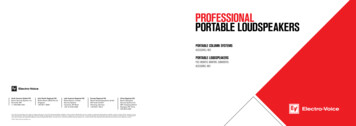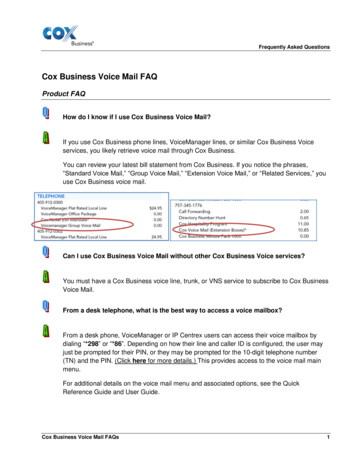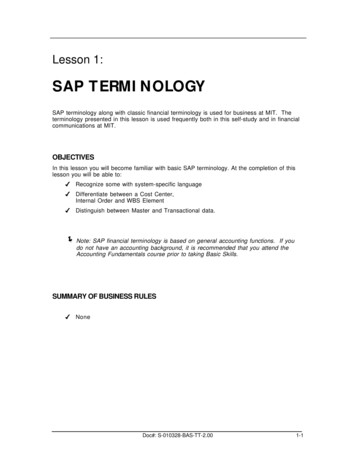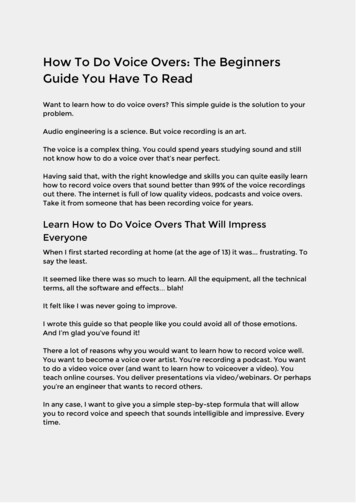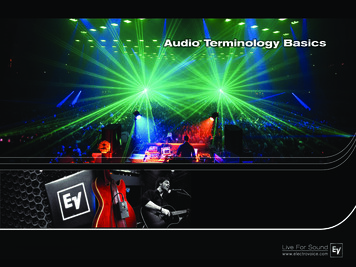
Transcription
Audio Terminology Basics 2012 Bosch Security Systems
Table of ContentsIntroduction 3A-I5J-R10S-Z13Wrap-up15 2012 Bosch Security Systems2
IntroductionAudio TerminologyAre you getting ready to buy a new amp? Is your band bookingsome bigger venues and in need of new loudspeakers? Are youjust starting out and have no idea what equipment you need?As you look up equipment details, a lot of the terminology canbe pretty confusing.What do all those specs mean? What’s a compression driver?Is it different from a loudspeaker? Why is a 4 watt amp cheaperthan an 8 watt amp? What’s a balanced interface, and whydoes it matter?We’re Here to HelpWhen you’re searching for the right audio equipment, you don’tneed to know everything about audio engineering. You just needto understand the terms that matter to you. This quick-referenceguide explains some basic audio terms and why they matter. 2012 Bosch Security Systems3
What makes EV the expert?Experience. Dedication. Passion.Electro-Voice has been in the audio equipment business since 1930. Recognized the world over as a leader in audio technology, EV isubiquitous in performing arts centers, sports facilities, houses of worship, cinemas, dance clubs, transportation centers, theaters, and,of course, live music. EV’s reputation for providing superior audio products and dedication to innovation continues today. Whether EVmicrophones, loudspeaker systems, amplifiers, signal processors, the EV solution is always a step up in performance and reliability. 2012 Bosch Security Systems4
Audio Terms: A-IAlternating Current (AC)ArrayAn electric current that repeatedly reverses direction.A loudspeaker system made up of a number of loudspeakerelements joined together.AmplifierAn electronic device used to increase the amplitude of theaudio signal fed into it.AmplitudeThe relative magnitude of the signal.A Column Array - Generally a singlecabinet with the elements of the arrayoriented in a straight line to providesome level of directivity at a range offrequencies.A Constant Curvature Array - Anarray of multiple boxes, each at thesame angle of seperation betweeneach array element.A Line Array is a loudspeaker system made up of a number of loudspeaker elements joined in a line tocreate a single sound source. Theloudspeakers must be close enoughtogether to send sound waves fartherthan individual loudspeakers, and witha more evenly distributed sound output pattern. 2012 Bosch Security Systems5
Balanced ConnectionComb FilteringA balanced connection allows for the use of long cableswhile reducing susceptibility to external noise. Professionalaudio products support a balanced connection. A typicalbalanced cable contains two identical wires, which aretwisted together and then wrapped with a third conductorthat acts as a shield. Three-pin XLR connectors are the mostcommon balanced connector, but quarter-inch (¼” or 6.35mm) TRS connectors (tip-ring-sleeve) are also commonlyused.Also called phase cancellation. A comb filter adds a delayed versionof a signal to itself, causing interference. Comb filtering can occurwhen two loudspeakers are playing the same signal at differentdistances from the listener. In an enclosed space, a listener hears amixture of direct sound and reflected sound. Because the reflectedsound takes a longer path, it sounds like a delayed version of thedirect sound, which is called comb filtering.BandwidthReducing the dynamic range of a signal for recording and thenexpanding it to its original value for reproduction or playback.The range of frequencies an amplifier or transducerproduces.CompandingCompression DriverCarrier SignalA high-frequency dynamic loudspeaker.A continuous signal of a single frequency capable of beingmodulated by a second, data-carrying signal.ConductorChannelThe designation of a unique path through a device from inputto output.ClippingMaterial that allows the flow of electrical charge.Coverage PatternA loudspeaker system’s directional pattern, which can vary byfrequency and tone.Audio distortion caused by pushing an amplifier to createa signal with more power than its source can produce (i.e.,overdriving an amp). The signal will cut off when it reachesmaximum capacity, which produces clipping. 2012 Bosch Security Systems6
CrossoverDirect Current (DC)An electrical circuit (passive or active) consisting of acombination of filters used to divide an audio frequency intosegments suitable for individual loudspeaker use.An electric current that does not change direction of flow.Active crossovers split frequency bands prior to amplificationof the audio signal.Passive crossovers split frequency bands after amplificationof the audio signal, just before reaching the individual loudspeaker components. Passive networks may cause power lossand usually aren’t capable of the fine tuning and adjustmentthat an active crossover provides.CurrentElectric current is the flow of electric charge through aconductor, such as wire.Cycles per Second (CPS)One cycle is the transition of a sine wave from 0 to positivecrest down through 0 to the negative crst and back to 0.One full cycle is shown in this graph. Cycles per Secondrefers to the number of times a full cycle is repeated inthe period of one second. Cycles per Second is usuallyexpressed as hertz (Hz). One hertz is equal to one cycle persecond. 2012 Bosch Security SystemsDecibel (dB)A logarithmic scale that is used to measure signal levels. Soundpressure level (SPL) can be measured in dB.Good to Know: Doubling electrical power only yields an increase of 3 dB. Increasing the power tenfold will yield an increase of 10 dBand is a doubling of perceived loudness.dBuDecibels unloaded; reference voltage for professional applications.The reference voltage for the decibel unloaded (0 dBu) is thevoltage required to produce 1 milliwatt (mW) of power across a 600Ω load (approximately 0.7746 VRMS). The most common nominallevel for professional equipment is 4 dBu.dBVDecibel volts; reference voltage for consumer applications. Thereference voltage for the decibel volt (0 dBV) is 1 VRMS, which isthe voltage required to produce 1 mW of power across a 1 kilohm(kΩ) load. The most common nominal level for consumer audioequipment is 10 dBV.7
DelayFrequencyAn electronic circuit that delays the audio signal for a shortperiod. Mixing delayed signals back with the original soundgenerates a number of audio effects.The number of times a wave repeats per second, measured in Hertz(Hz).Digital Signal Processor (DSP)A device which receives an audio signal and trypicall.Direct Box (DI box)A device that enables a musical instrument to be connecteddirectly to a mic- or line-level mixer input.DistortionThe alteration of the original shape (or other characteristic) ofa sound wave which changes the sound. Distortion is usuallyunwanted, but it may be stylistically desirable for certaininstruments, such as an electric guitar. The three principaltypes of intentional distortion effects are overdrive, distortion,and fuzz.DiversityThe method of minimizing the effects of multipath delays thatcan create drop-outs of the RF signal.Efficiency (in loudspeakers)Sound power output divided by the electrical power input. 2012 Bosch Security SystemsFrequency Response is given as the range of frequencies betweenthe points at the upper and lower ends of the sounds spectrum, wherethe speaker response is 3 dB below the nominal output level. Thisindicates that the system is starting to have a reduced output belowthis frequency.Frequency Range is given as the range of frequencies between thepoints at the upper and lower ends of the sound spectrum, wherethe speaker response is 10 dB below the nominal output level. This iscommonly referred to as the lower and upper limit of the system’s usable output. Anything below or above this frequency range should notbe expected to be reproduced from the system.FilterA frequency-dependent amplifier circuit designed to amplify, pass,or attenuate certain frequency ranges.A Low-Pass Filter allows frequencies below its cutoff to pass andprogressively attenuates frequencies above the cutoff.A High-Pass Filter allows frequencies above its cutoff to pass andprogressively attenuates frequencies below the cutoff.A Bandpass Filter passes frequencies between its two cutoff frequencies; attenuates frequencies outside the rangeBand-Reject Filter –attenuates frequencies between its two cutofffrequencies; passes frequencies not within the “reject” range.8
GroundGround, or “earth,” is the point of zero voltage in a circuit orsystem. It’s the reference point from which all other voltagesare measured. Professional audio equipment should maintaina good technical ground and operate with a good safetyground.HertzUnits of frequency. One hertz is equal to one cycle persecond.Impedance (Z)The amount of resistance offered by an electronic circuitor device to the (AC) current that flows through it. It iscommonly represented by the mathematical symbol “Z” andis measured in Ohms.InputConnection from a signal source.Inverse-Square LawEach doubling of distance from a sound’s point sourceresults in a -6 dB change in SPL. 2012 Bosch Security Systems9
Audio Terms: J-RLimiterMagnitudeA circuit that allows signals below a specified inputpower to pass unaffected while attenuating the peaks ofstronger signals that exceed this input power. A limiter isa compressor with a high ratio and, generally, a fast attacktime.The value of a voltage or current waveform.LoudspeakerAn electroacoustic transducer that produces sound inresponse to an electrical audio signal input. May refer toindividual transducers (or “drivers”) or to complete speakersystems consisting of more than one. To reproduce awide range of frequencies, most loudspeaker systems usemore than one driver. Individual drivers reproduce differentfrequency ranges.SubwooferA loudspeaker designed to reproduce bass frequencies.TweeterA small loudspeaker designed for the reproduction of highfrequency sounds.MicrophoneAn acoustic-to-electric transducer that converts sound into anelectrical signal.Condenser MicrophoneA microphone where a condenser (capacitor) is created bystretching a thin diaphragm in front of a metal disc (the backplate). Condenser microphones require external voltage to operate, which is normally supplied in the form of phantom powerfrom the microphone preamp or the mixing console.Dynamic MicrophoneA microphone design where a wire coil is attached to a smalldiaphragm. Sound pressure causes the coil to move in a magnetic field, thus creating electrical voltage proportional to thesound pressure. They’re rugged, robust and reliable microphones that add coloration to the audio signal. Since dynamicmicrophones have a weaker signal than condenser mics, theymust be placed relatively close to the audio source.WooferA loudspeaker designed for the reproduction of low-frequencysounds. 2012 Bosch Security Systems10
DirectionalSound reflected from surfaces behind a directional microphone’s diaphragm is permitted to be incident on the rear sideof the diaphragm. Since the sound reaching the rear of thediaphragm travels slightly farther than the sound at the front, itis slightly out of phase. The greater this phase difference, thegreater the pressure difference and the greater the diaphragmmovement. As the sound source moves off the diaphragmaxis, this phase difference decreases due to decreasing pathlength difference. This is what gives a directional microphoneits directivity.CardioidA type of microphone that has a heart-shaped polar, or directional, pattern. It is the most common unidirectional microphone in use because it effectively rejects sound from otherdirections.MultipathIn wireless systems, it is interference due to multiple arrivals of thesame RF signal due to reflections off nearby objects. The differencein path lengths creates different arrival times, thus causing signalcancellation and degradation.SpeakonA type of cable connector mostly used in professional audio systemsfor connecting loudspeakers to amplifiers. Speakon connectorsare a higher current-carrying alternative to other connectors forloudspeakers. NL4 is a type of Speakon connector that has fourelectrical connections.Ohm (Ω)Hyper-CardioidA type of microphone with a tighter area of front sensitivity anda smaller lobe of rear sensitivity.Measurement of the resistance in an electrical conductor, whichcan be calculated using the R V / I (resistance voltage/current)equation.OmnidirectionalAlso called nondirectional, this type of microphone’s responseis generally considered to be a sphere in three dimensions.Power RatingSuper-CardioidSimilar to a hyper-cardioid microphone, except there is morefront pickup and less rear pickup.The electrical output of the amplifier module based on a set oftest parameters. There are many different kinds of power ratingsfor amplifiers and speakers, which can make comparisons difficultunless you identify the ratings that use the same test parameters.Mixing ConsolePreampAlso called a soundboard, a mixing console is an electronicdevice for combining, routing, and changing the level, timbreand/or dynamics of audio signals.Preamplifier; device that amplifies the weak electrical signals frommicrophones and pickups used to record voices and musicalinstruments to professional line level. 2012 Bosch Security Systems11
Proximity EffectReceiverAn increase in bass or low frequency response when a soundsource is close to a microphone. Proximity effect is caused bythe ports that create directional polar pickup patterns, so omnidirectional mics are not affected.An electronic device, with an antenna, that receives audio wavesand converts the information carried by them to an audio signal. Theantenna intercepts electromagnetic waves and converts them toalternating currents, which are applied to the receiver; the receiverextracts the audio. The receiver uses electronic filters to separatethe wanted audio frequency signal from all other signals. 2012 Bosch Security Systems12
Audio Terms: S-ZSensitivity (in loudspeakers)Signal VoltageA certain number of decibels at 1 W electrical input,measured at 1 meter, often at a single frequency. Driverratings based on the SPL for a given input are calledsensitivity ratings.The effective voltage value of the signal that leaves or feeds anaudio device.ShieldingA shielded cable is an electrical cable of one or moreinsulated conductors enclosed by a common conductivelayer. The shield may be composed of braided strands ofmetal, a non-braided spiral winding of copper tape, or a layerof conducting polymer. Usually, this shield is covered with ajacket. The shield reduces electrical noise and interference.In shielded signal cables the shield may act as the returnpath for the signal, or may act as screening only.Line LevelWithin a sound system, signals of various levels enter a mixer, but thesignal that leaves the mixer is at professional “line level.” The standardis 4 dBu or -10 dBV audio levels, or approximately 1V.Mic LevelThe relatively low-level signal (generally -40 dBV to -60 dBV) of microphone or pickup output that must be amplified to line level, where it ismore easily manipulated by a mixing console.Speaker LevelSignals stronger than line level that are used to drive headphones andloudspeaker. Produced by amplifiers.Signal-to-Noise Ratio (SNR)Signaling Reference Voltage (dBu and dBV)A measure that compares the level of a desired signal to thelevel of background noise.See entries for dBu and dBV.Signal Path/ChainPath taken by a signal. This can either be from the input tothe output of one device, or the path taken through manydifferent devices (e.g., from microphone to mixing desk /signal processing devices then amplifier(s), speakers, etc.) 2012 Bosch Security SystemsSinusoidal (Sine) WaveAn oscillation whose waveform is that of a sine curve, e.g., a soundwave or and electrical wave. Audio signals are sine waves.13
Sound Pressure Level (dB SPL)Watt (W)The loudness of an acoustic wave stated in dB.A unit of power in the International System of Units equal to onejoule per second. Watts of electrical power equals volts timesamperes.SquelchA function that mutes the audio output of a receiver whenthere isn’t a strong enough radio frequency (RF) signalpresent at the antennas. Most professional level wirelessmicrophones have adjustable squelch.XLR cable/connectorTransmitterZAn electronic device which produces radio frequency (RF)signal. The transmitter itself generates a radio frequencyalternating current, which is applied to the antenna. Whenexcited by this alternating current, the antenna radiates radiowaves.The electrical symbol for impedance.A style of electrical connector most commonly associated withbalanced audio interconnection.Unbalanced ConnectionConsumer audio products use unbalanced connections, orinterfaces. An unbalanced connection requires the use ofshort audio cables and is susceptible to external interference.An unbalanced interface uses coaxial wire and connectorswith two electrical contacts.VoltageElectric force or potential difference expressed in volts. 2012 Bosch Security Systems14
Wrap-UpThe More You KnowNow that you understand the specs that matter to you, you should be ready tomake some decisions about your audio components and hit the road.Ready to Get Started?We hope this list helped you get a grip on some audio terms you’re going to encounter when choosing your audio equipment. If you needadditional information or help, visit Electro-Voice online at http://www.electrovoice.com. 2012 Bosch Security Systems15
mixture of direct sound and reflected sound. Because the reflected sound takes a longer path, it sounds like a delayed version of the direct sound, which is called comb filtering. Companding Reducing the dynamic range of a signal for recording and then expanding it to its origin
